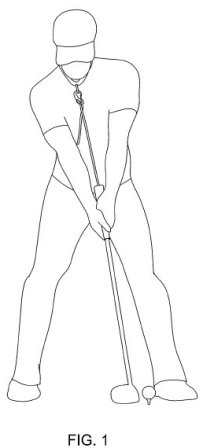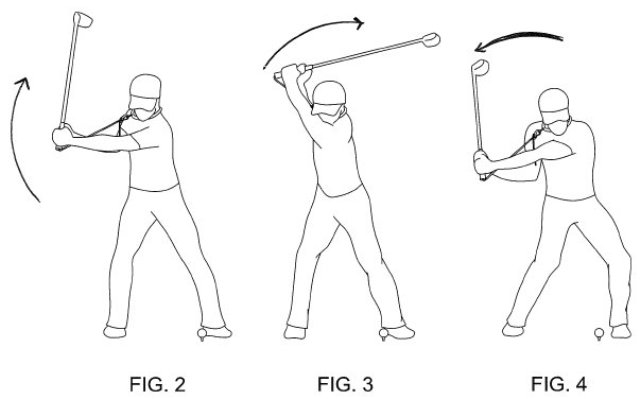Want to Add Some Excitement to Your Practice? Are You Brave Enough for This Training Aid?
What do you think: safe effective training aid or merely a maker of a raw ring around your neck?

The drawing comes from a patent that issued this week as USPN 8,632,414 titled “Feedback-Based Golf Swing Training Aid.” The patent explains:
Dave Dawsey - The Golf Training Aid Invention Attorney
PS – Check out more unusual golf training inventions here, here, and here.

The drawing comes from a patent that issued this week as USPN 8,632,414 titled “Feedback-Based Golf Swing Training Aid.” The patent explains:
Among the more specific and salient objects of the invention disclosed and claimed in the present application are to provide a golf swing training and aid device that promotes or encourages: 1. a more comfortable and more effective grip; 2. a stance and posture more conducive to produce good golf shots and to preserve the player's balance; 3. a one-piece take away; 4. a wider and stronger shoulder turn which results in more power; 5. a parallel position of the club relative to the shoulders at the top of the backswing; 6. a more efficient position of the club and club head at the start of the downswing thus promoting an "in-out" swing trajectory and minimizing the possibility of "casting" (out-in swing trajectory) of the club with the hands or shoulders; 7. an increasingly stronger (more club head speed) impact position; 8. a vertical follow through; 9. more efficient swing, tempo and timing; and 10. a balanced swing finish.Birdie or bogey? I would try it.
.
.
.
To begin using the device of this invention, the user takes each end (14) of the neck collar (1) in the left and right hand, respectively and places it around his or her neck. The collar is capable of being adjusted, loosened or tightened per the user's preference, via the collar's adjustable attachment means (2). To properly use the device of this invention, the user should adjust the collar's attachment means (2) so that the collar maintains about one inch of slack in the front end of the user's neck. The user then attaches the detachable engagement means (an adjustable plastic hook already attached to the feedback means in the preferred embodiment of the invention) (4) to the collar's receiving means (3). Next, the user can adjust the tension of the graduated feedback means (5) by holding a golf club's grip to which the graduated feedback means is attached (6), assuming an address position suitable to the user, and pulling the top end of the Bungee cord (5) until the user feels a moderate amount of tension on the back of the neck. While doing so, the user will also feel a moderate amount of tension in the hands when the golf club is grounded in the address position and the detachable engagement means (4) is properly attached to the graduated feedback means (5). If the user has not previously done so, the user can then record the number corresponding to the tension appropriate to the user's height, arm length and other physical attributes, if using an embodiment of the invention that includes a graduated feedback means.
The tension the user feels on the back of the neck promotes better stance and posture as it reminds the golfer to keep the flex in the spine, hips and knees and eliminate a common golf swing flaw of lifting the head or looking up too soon during the downswing.
The user is now ready to begin using the golf swing training and aid device of the present invention. To achieve optimal results, the user holds onto the grip (6), which can be a commercially available training grip which provides the correct hand and proper grip position, i.e., a neutral grip. The feedback the invention provides, combined with using a commercially available training grip, as depicted in FIG. 8, provides the required "feel" to allow the user to incorporate a proper position and pressure of the hands on the grip into his or her golf game in actual playing conditions.
As illustrated in FIG. 1, the feedback means at the address position is capable of forming a straight line from the user's chin to the sternum to the navel to the groin. The preferred angle of the feedback means is 180 degrees from the collar's receiving means (3) to the end of the grip (6). That tension position of the feedback means is then maintained throughout the entire swing. As the user begins his or her take away movement, hands, arms, shoulders and feedback means will move together away from the body, eliminating an ill-timed or disconnected take-away. The plane of the feedback means (5) has a natural tendency to stay in line with the center of the user's torso. By attempting to maintain the feedback means' constant tension through the backswing (FIG. 2) all the way to the top of the swing (FIG. 3), the apparatus of this invention promotes the reduction and, in most cases, the elimination of a flawed, shortened swing plane. Once the user's hands start dropping downward, he or she must maintain the feedback means (5) on a vertical plane and with constant tension all the way through the downswing (FIG. 4). Doing so greatly reduces or eliminates the most common swing flaw in golf--casting of the club with either the hands or right shoulder. At impact the user, while maintaining the constant tension and proper angle of the feedback means will achieve a maximized, strong impact position (FIG. 5). The proper use of the device of this invention also promotes a strong and straight left arm through the golf swing, thus reducing or eliminating the flawed "chicken wing" and overactive right hand or "scooping" of the club at impact. As the golfer maintains the feedback means' tension and angle, he or she will finish the swing at a tall and vertical position (FIGS. 6 and 7), reducing or eliminating a common golf swing flaw--quick inside or horizontal finish. Finally, while using the device with the feedback means (5) at a constant tension and angle, the user will likely stay in balance and prevent a common golf swing flaw--adjustment of the feet relative to the ball at impact or shortly thereafter to keep from falling forward.
Dave Dawsey - The Golf Training Aid Invention Attorney
PS – Check out more unusual golf training inventions here, here, and here.



Comments